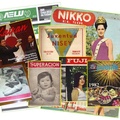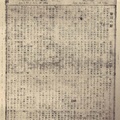Read Part 1 >>>
Eight years later, on January 1,1929, another newspaper was founded, Perú Nichi Nichi Shimbun (Daily News of Peru), with the goal of taking part in the debate. It was understood that the Japanese readership should neither be polarized nor silent witnesses in the polemic that had sustained the other two newspapers. This new publication was directed by Susumu Sakuray who had been the editor of . It was distinguished for having a more modern look and for including the most recent news that were received via cable and radio.
After a short time Tanaka had to leave his post because he was named an official of the Punizas Settlement in the Perené Zone (the jungle sector of Peru), a project that had been created by Minister Saburo Kurusu with an eye toward decentralizing the Japanese community in Lima. Sakuray assumed the leadership of the newspaper, while his brother, Hiromu Sakuray, took up a managerial post and Akio Hanno became chief editor.
At the end of five years and under the charge that the Okinawans had influenced the editorial line of the newspaper, changes began to take place in the company, obliging the Sakuray Brothers to quit. Choko Shinjo, who had studied economics at the University of Meiji in Tokyo, and who had journalism experience working at various Japanese newspapers, assumed the leadership of Lima Nippo, a position that he maintained for several years until he returned to his native land. After his experience with Punizas, Tanaka returned to Lima and once again took charge of the newspaper.
Six months later, Jutaro Tanaka, one of the publishers of Nippi Shimpo, managed to merge the three newspapers and publish a new one, Lima Nippo (Daily Bulletin of Lima). He argued that for such a small community it was not necessary to waste such efforts publishing three newspapers; rather, it was better to save supplies and offer the readership one good newspaper. This is how the newspaper was born in July 1929; Tanaka himself was named manager of the new company, and Sakuray, the former manager of Andes Jiho and Perú Nichi Nichi Shimbun, was named editor.
After only a month had passed since the debut of Lima Nippo another newspaper, Peru Jiho (Chronicles of Peru), began to circulate in the city, and it was supported by those who had opposed the merger of the original three newspapers. Kuninosuke Yamamoto assumed the leadership for two years, and in 1931, it passed to Hisao Ikeyama, a graduate of the University of Tokyo, who, thanks to his editorials that made the newspaper competitive, managed to stamp his own personal seal on the newspaper. Thereafter, a portion of the paper was published in Spanish, while some of the first Peruvians of Japanese descent worked on the newspaper, including Víctor Tateishi, Luis Okamoto, Julio Matsumura, Alberto Mochizuki, Enrique Shibao and Chihito Saito.
In July 1941, Susumu Sakuray, who had earlier left the paper Lima Nippo, published the Peru Hochi (Reports of Peru), which now brought the number of newspapers circulating in the community back to three. It was World War II, and there was great interest in getting the most recent news coming out of Europe and then Asia. However, when Japan became involved in the war and Peru declared war against Japan, the Peruvian government closed down and confiscated Japanese newspapers. The government also deported the major players in the Japanese community, including those Japanese who had become Peruvian citizens, as well as Peruvians of Japanese descent.
* This article is published under an agreement between the San Marcos Foundation for the Development of Science and Culture at the National University of San Marcos and the Japanese-American National Museum and its Discover Nikkei project.
© 2010 Alejandro Sakuda








